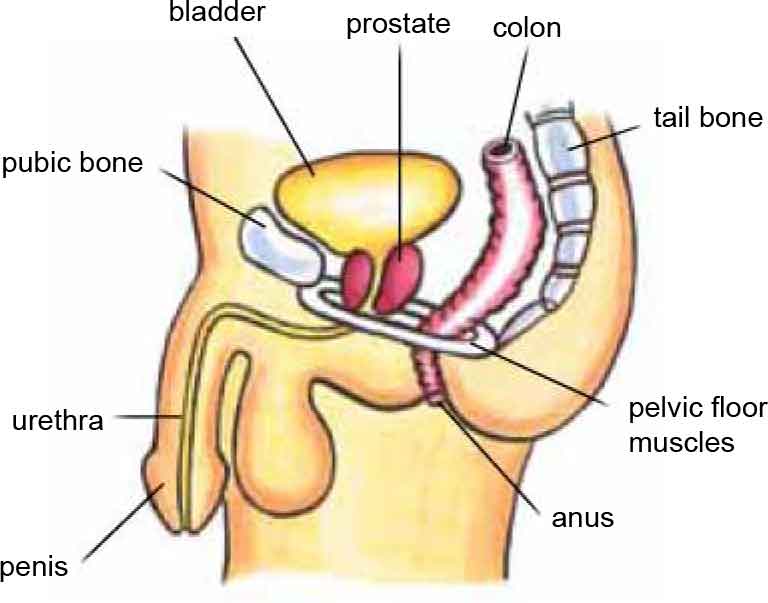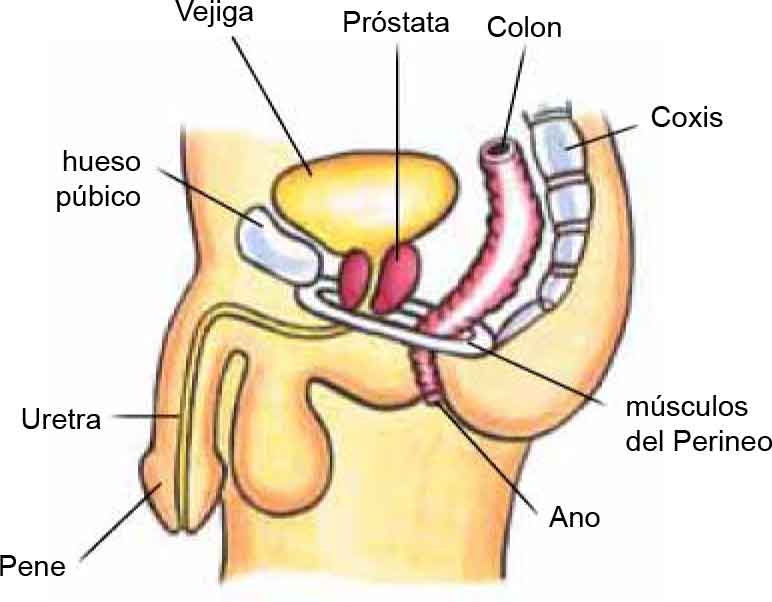What are the pelvic floor muscles?The floor of the pelvis is made up of layers of muscle and other tissues. These layers stretch like a hammock from the tailbone at the back, to the pubic bone in front. A man’s pelvic floor muscles support his bladder and bowel (colon). The urine tube and the back passage pass through the pelvic floor muscles. Your pelvic floor muscles help you to control your bladder and bowel. They also help sexual function. It is vital to keep your pelvic floor muscles strong. |
¿Qué son los músculos del suelo pélvico o perineo?El perineo está formado por capas de músculos y de otros tejidos. Estas capas van dispuestas como una hamaca desde el coxis en la parte posterior hasta el hueso púbico en la anterior. En el hombre los músculos del perineo sostienen su vejiga y el intestino (el colon). El conducto urinario (uretra) y el recto pasan a través de los músculos del suelo pélvico. Dichos músculos lo ayudan a controlar su vejiga e intestino. También ayudan en la función sexual. Es vital que usted mantenga fuertes sus músculos de perineo. |
|
|
|
Why should i do pelvic floor muscle training?Men of all ages need to have strong pelvic floor muscles. Pelvic floor muscles can be made weaker by:
Men with stress incontinence – that is, men who wet themselves when they cough, sneeze or are active – will find pelvic floor muscle training can help in getting over this problem. Pelvic floor muscle training may also be of use for men who have an urgent need to pass urine more often (called urge incontinence). Men who have problems with bowel control might find pelvic floor muscle training can help the muscle that closes the back passage. This muscle is one of the pelvic floor muscles. |
¿Por qué me conviene hacer ejercicios para los músculos del perineo?Los hombres necesitan tener fuertes músculos del perineo, cualquiera sea su edad. Los músculos pélvicos pueden debilitarse debido a:
En el caso de los hombres que sufren de incontinencia en momentos de tensión (es decir, se les escapa orina al toser, estornudar o hacer alguna actividad física), verán que hacer ejercicios para los músculos del perineo los ayudará a superar este problema. El ejercitar los músculos pélvicosla musculatura pélvica será de utilidad a los hombres que sufren de repentina urgencia de orinar en forma más frecuente (la llamada incontinencia apremiante). Los hombres que sufren problemas de control intestinal verán que los ejercicios para los músculos del perineo ayudan a robustecer el músculo que cierra el recto. Dicho músculo es uno de los músculos pélvicos. |
Where are my pelvic floor muscles?The first thing to do is to find out which muscles you need to train.
If you don’t feel a distinct “squeeze and lift” of your pelvic floor muscles, or if you can’t slow your stream of urine as talked about in Point 3, or you do not see any lift of your scrotum and penis as talked about in Point 4, ask for help from your doctor, physiotherapist, or continence nurse. They will help you to get your pelvic floor muscles working right. Men with very weak pelvic floor muscles can benefit from pelvic floor muscle training. |
¿Dónde se encuentran mis músculos pélvicos?Lo primero es determinar cuáles son los músculos que usted necesita ejercitar.
Si usted no siente un característico “apretar y levantar” de sus músculos pélvicos, o si no le es posible aminorar el chorro de orina mencionado en el punto 3, o si no observa ningún movimiento del escroto y el pene tal como se menciona en el punto 4, entonces solicite la ayuda de su médico, fisioterapeuta o del personal de enfermería especializado en incontinencia. Le ayudarán a lograr el buen funcionamiento de sus músculos pélvicos. Los hombres cuyos músculos pélvicosson muy débiles se beneficiarán con los ejercicios para dichos músculos. |
How do i do pelvic floor muscle training?Now that you can feel the muscles working, you can:
While doing pelvic floor muscle training:
|
¿Cómo puedo hacer ejercicios para los músculos pélvicos?Ahora que puede sentir los músculos en acción, le será posible:
Mientras realiza los ejercicios para los músculos pélvicos:
|
Do your pelvic floor muscle training wellFewer good squeezes are better than a lot of half hearted ones! If you are not sure that you are doing the squeezes right, or if you do not see a change in symptoms after 3 months, ask for help from your doctor, physiotherapist, or continence nurse. |
Ejecute los ejercicios para los músculos pélvicos con la mayor correcciónUna cantidad pequeña de buenos apretamientos ¡es mejor que muchos hechos a medias! Si no está seguro de cuán bien los hace, o si no observa un cambio en los síntomas luego de 3 meses, solicite la ayuda de su médico, fisioterapista o de personal de enfermería especializado en incontinencia. |
Make the training part of your daily lifeOnce you have learnt how to do pelvic floor muscle squeezes, you should do them. Every day is best. You should give each set your full focus. Make a regular time to do your pelvic floor muscle squeezes. This might be after going to the toilet, when having a drink, or when lying in bed. Other things you can do to help your pelvic floor muscles:
|
Incorpore estos ejercicios a su vida cotidianaApenas haya aprendido a hacer los apretamientos de los músculos pélvicos, ¡hágalos! Lo mejor es hacerlos todos los días. Haga cada serie de apretamientos con el máximo de concentración. Trate de dedicar un mismo momento del día a estos ejercicios. Por ejemplo, luego de ir al baño, o al tomar un refresco, o al estar tendido en la cama. Otras actividades para mejorar sus músculos pélvicos:
|
Seek helpQualified nurses are available if you call the National Continence Helpline on 1800 33 00 66* (Monday to Friday, between 8.00am to 8.00pm Australian Eastern Standard Time) for free:
If you have difficulty speaking or understanding English you can access the Helpline through the free Telephone Interpreter Service on 13 14 50. The phone will be answered in English, so please name the language you speak and wait on the phone. You will be connected to an interpreter who speaks your language. Tell the interpreter you wish to call the National Continence Helpline on 1800 33 00 66. Wait on the phone to be connected and the interpreter will assist you to speak with a continence nurse advisor. All calls are confidential. * Calls from mobile telephones are charged at applicable rates. |
Busque ayudaEl personal de enfermería especializado está disponible llamando gratuitamente a la Línea Nacional de Ayuda para la Incontinencia al 1800 33 00 66* (de lunes a viernes, de 8:00 a 20:00 horas, hora estándar del este de Australia):
Si usted tiene dificultad para hablar o entender Inglés puede acceder a la línea de ayuda a través del Servicio Telefónico gratuito de Intérpretes llamando al 13 14 50. Contestarán a la llamada en ingles, entonces usted diga el nombre del idioma que habla y espere en el teléfono. Le pondrán en contacto con un intérprete que hable su idioma, entonces diga que quiere llamar a la Línea Nacional de Ayuda para la Incontinencia al 1800 33 00 66. Espere a que conecten el teléfono y luego el intérprete le ayudará a hablar con un profesional de enfermería que podrá aconsejarle sobre la incontinencia. Todas las llamadas son confidenciales. * Las llamadas desde teléfonos celulares se cobran a las tarifas aplicables. |
Pelvic Floor Muscle Training for Men in Spanish
Ejercicios Para Los Músculos Del Perineo O Suelo Pélvico Masculino
Last Updated: Fri 30, Jul 2021
Last Reviewed: Tue 17, Mar 2020



